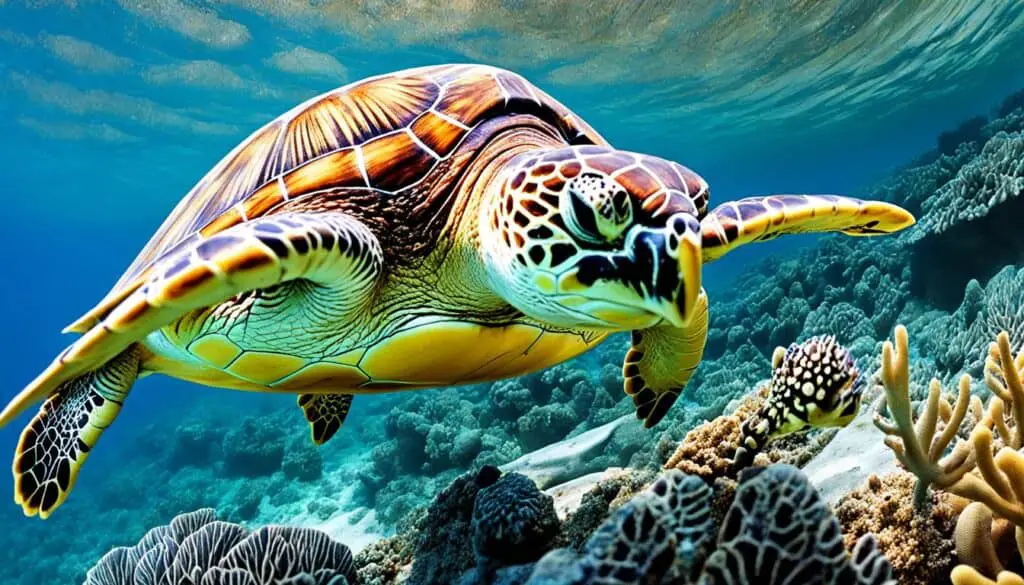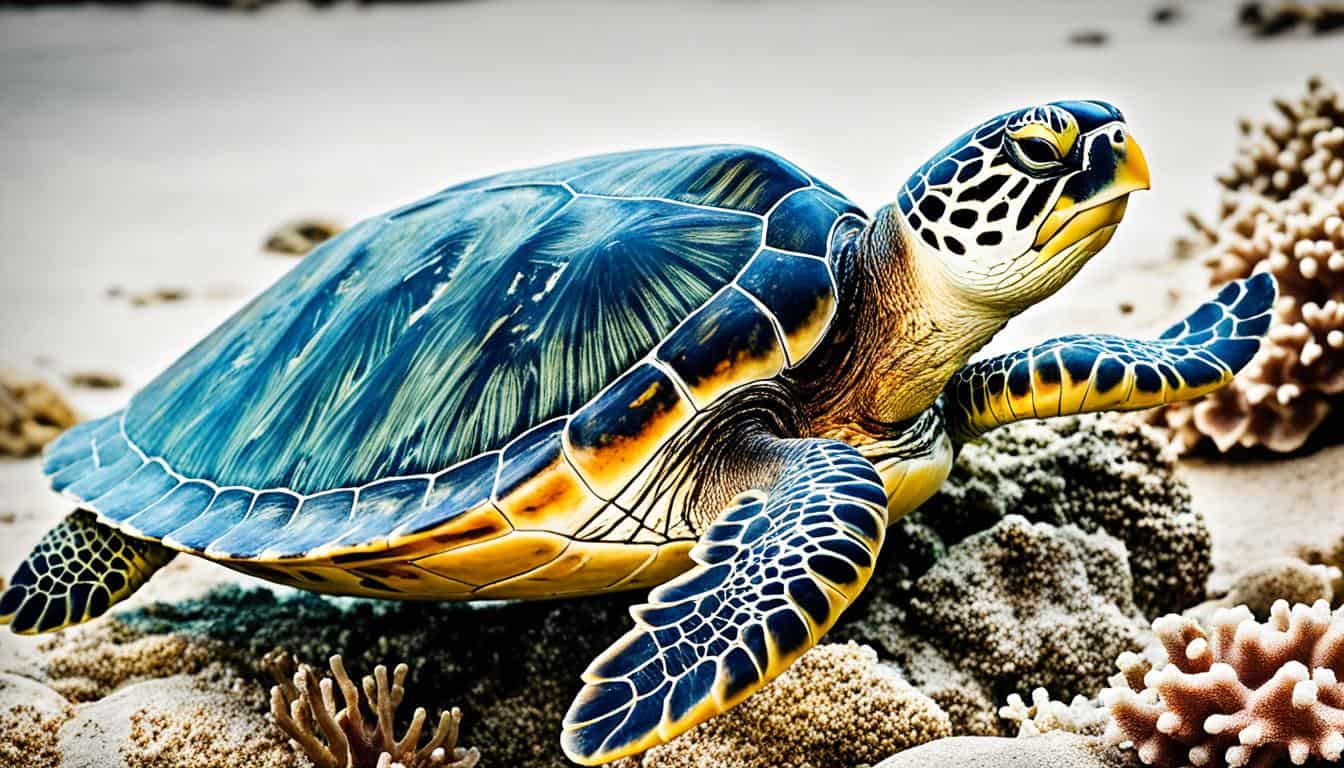Are you ready to start an adventure with sea turtles? These ancient creatures have been around for about 110 million years. They are fascinating and play a big role in keeping our oceans healthy.
In this article, you’ll learn about the different kinds of sea turtles. You’ll see their special features and how they help the ocean. Knowing about these amazing creatures will make you appreciate them more and understand why we need to protect them.
Let’s dive into the different types of sea turtles. You’ll find out about their unique traits. Get ready for an interesting look at how they fit into our world and their importance to us.
Introduction to Sea Turtles
Sea turtles are fascinating creatures that belong to marine reptiles. They have special features for living in the ocean. Learning about introduction to sea turtles shows their beauty and important roles in the sea.
These animals live mostly in the water and need air to breathe. This makes them stand out in sea turtle biology.
Sea turtles can’t pull their heads or limbs into their shells, which makes them look sleek. They have long flippers and strong shells for swimming long distances. They are crucial for the ocean’s health, eating plants and helping to keep the sea stable.
Studying these amazing sea creatures shows how they help the ocean. They shape the sea floor and support many types of sea life.
The Importance of Sea Turtles in Marine Ecosystems
Sea turtles are key to the health of marine ecosystems. They help keep the ocean’s balance. By eating jellyfish, they control their numbers, which is good for other sea creatures.
Sea turtles also play a big role when they nest on beaches. Female turtles dig nests, which helps the next generation and coastal ecosystems. This action improves the soil, helping plants grow. So, sea turtles help not just in the ocean but also on the coast.
Without sea turtles, marine ecosystems could face big problems. They support a wide variety of life and keep the ocean’s balance. By protecting sea turtles, we help keep these ecosystems healthy for the future.
What are the different species of sea turtles?
Sea turtles come in many types, which is important for those who love the ocean and want to protect it. Knowing the different sea turtle species helps us appreciate these amazing animals more. There are seven main types, each with its own special traits and places to live.
Overview of Sea Turtle Species
The sea turtles include:
- Green Sea Turtle
- Hawksbill Sea Turtle
- Kemp’s Ridley Sea Turtle
- Leatherback Sea Turtle
- Loggerhead Sea Turtle
- Olive Ridley Sea Turtle
- Flatback Sea Turtle
Unique Characteristics of Each Species
Each sea turtle species has its own special features:
| Species | Size | Habitat | Diet |
|---|---|---|---|
| Green Sea Turtle | 3 to 4 feet | Warm coastal waters | Herbivorous |
| Hawksbill Sea Turtle | 2.5 to 3.5 feet | Tropical coral reefs | Coral and sponges |
| Kemp’s Ridley Sea Turtle | 2 to 3 feet | Gulf of Mexico | Crabs |
| Leatherback Sea Turtle | 4 to 8 feet | Open oceans | Jellyfish |
| Loggerhead Sea Turtle | 2.5 to 3.5 feet | Temperate and tropical oceans | Crustaceans |
| Olive Ridley Sea Turtle | 2 to 3 feet | Open ocean | Jellyfish and sea urchins |
| Flatback Sea Turtle | 3 to 4 feet | Australian waters | Soft corals and algae |
Sea Turtle Varieties and Their Habitats
Exploring the different sea turtle varieties shows how they live in various marine habitats. Each species has its own way of adapting to its environment. For example, the Green sea turtle lives in shallow seagrass beds. These beds are crucial for its survival because they provide food.
The Loggerhead sea turtle prefers the open ocean. They use ocean currents to travel long distances to find jellyfish, their main food. Each sea turtle variety uses its habitat’s resources in unique ways, showing how well they adapt.
Nesting beaches are key for sea turtles. Adult females go back to their birth beaches to lay eggs. This helps increase their species’ chances of survival in different marine ecosystems. Protecting these beaches is crucial for the future of sea turtles.

| Sea Turtle Variety | Preferred Habitat | Main Food Source |
|---|---|---|
| Green Sea Turtle | Shallow seagrass beds | Seagrass and algae |
| Loggerhead Sea Turtle | Open ocean currents | Jellyfish |
| Leatherback Sea Turtle | Deep ocean waters | Jellyfish and soft-bodied animals |
| Hawksbill Sea Turtle | Coral reefs | Sponges and invertebrates |
| Olive Ridley Sea Turtle | Coastal areas and nesting beaches | Crustaceans and mollusks |
Sea Turtle Conservation Efforts
Helping sea turtles is crucial for their survival. These amazing creatures face many dangers. Knowing these threats is key to saving them.
Threats Facing Sea Turtles Today
Sea turtles face many dangers that threaten their lives. The main issues include:
- Habitat destruction: Humans building near the coast harm their homes.
- Accidental capture: Fishing gear often traps and hurts sea turtles.
- Marine debris: Eating plastic can make turtles very sick.
- Climate change: Warmer temperatures and rising seas hurt their homes and food.
Even natural dangers are a problem, but humans cause the biggest harm. We must act fast to save these turtles.
Protection Policies and Global Cooperation
Strong laws are key to protecting sea turtles. Many countries have joined together to help. Some important steps include:
- Convention on International Trade in Endangered Species (CITES): This stops overhunting and trade.
- Sea Turtle Recovery Plans: These plans bring together local people and experts.
- Monitoring programs: These track turtle numbers and health.
Working together worldwide helps sea turtles. Countries share knowledge and resources. This makes saving sea turtles more effective against their dangers.
Fascinating Adaptations of Sea Turtles
Sea turtles have amazing adaptations that help them survive in the ocean. Their bodies have changed over time to fit their marine life. These changes let them live well, especially when they migrate and nest.
Anatomy and Physiology Adaptations
Sea turtles have incredible features for living in the ocean. Some key parts of their bodies include:
- Streamlined shells that cut through water easily, helping them swim fast.
- Large flippers for strong swimming and long journeys during migrations.
- Exceptional lung capacity, letting them dive deep and breathe for a long time.
- Resilience to pressure changes, crucial for deep diving in the ocean’s tough conditions.
Migration Patterns and Nesting Behavior
Migration is key to sea turtles’ lives. They travel thousands of miles between places they eat and lay eggs. When it’s time to lay eggs, females go back to where they were born. This shows how they’ve adapted to survive and reproduce.
Fun Facts about Sea Turtles
Sea turtles have been in the oceans for millions of years. They can live over 50 years, with some living up to 100 years. This shows how well they adapt to different environments.
Sea turtles have special glands near their eyes to get rid of salt. This makes some people think they are crying, but they are actually controlling their salt levels. This is just one of the many amazing things about them.
These reptiles have incredible migration patterns. For example, the leatherback sea turtle travels thousands of miles each year. Their long journeys and unique behaviors make them fascinating to learn about. Sharing sea turtle facts is always interesting and shows how important they are to the ocean.
FAQ
What are the different species of sea turtles?
There are seven kinds of sea turtles. They include the Green, Hawksbill, Kemp’s Ridley, Leatherback, Loggerhead, Olive Ridley, and Flatback. Each type has its own special traits and lives in different parts of the ocean, from warm to cold waters.
Why are sea turtles important for marine ecosystems?
Sea turtles are key to keeping marine ecosystems healthy. They eat jellyfish, which helps control their numbers. Their nesting helps balance the environment on beaches.
How do sea turtles adapt to their ocean environments?
Sea turtles have evolved to live in the sea. They have streamlined shells, big flippers, and can hold their breath for a long time. These features help them move through the water effectively.
What are the main threats facing sea turtles today?
Sea turtles face many dangers. These include losing their homes to buildings, getting caught in fishing gear, getting tangled in trash, and climate change affecting their nesting sites.
How long can sea turtles live?
Sea turtles can live over 50 years. Some may even live more than 80 years. How long they live depends on their environment and the dangers they face.
Where do sea turtles nest, and how does it affect their survival?
Adult sea turtles come back to their birth beaches to lay eggs. This is vital for their species to survive. Nesting helps the sand breathe and supports coastal life, showing how important good nesting places are for them.
Can sea turtles migrate, and if so, how far do they travel?
Yes, sea turtles migrate long distances. Some travel thousands of miles between where they eat and lay eggs. This journey is crucial for finding food and breeding successfully.
What unique features do different sea turtle species have?
Each sea turtle species is special. For example, the Green sea turtle eats seagrasses, and the Hawksbill eats sponges. These differences help each species live well in its own home.







